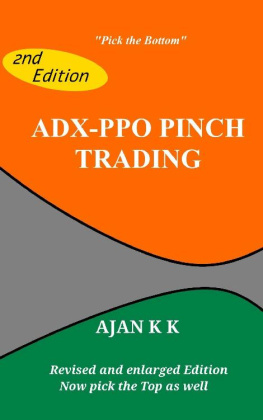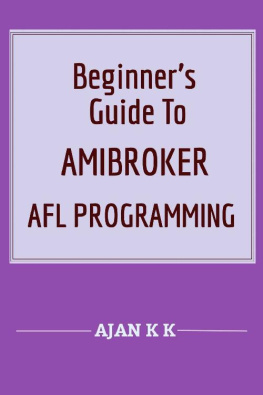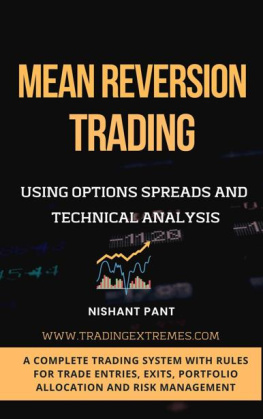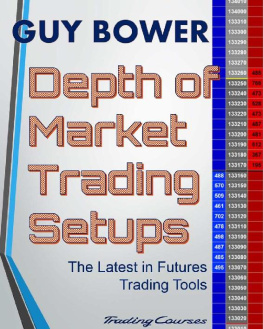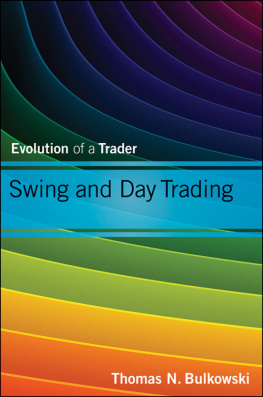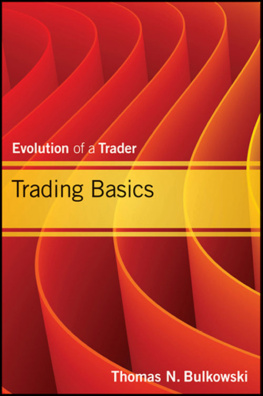ADX-PPO PINCH TRADING
Pick the Bottom
K K AJAN
This Book is dedicated to
My Parents
Copyright 2018 by K K Ajan
All rights reserved
Disclaimer:
Trading involves risk. This book is for educational purposes only. This is not an investment advice book. The author or publisher is not responsible for any financial loss occurred by trying the methods suggested in this book.
Preface to the 2 nd Edition
After the publication of the first Edition of this book, I found that majority of the readers for this book were from the United States. I started thinking I should have included example charts for securities that are traded in the US. This has led me to include chart examples from the US markets for the benefit of those readers who happened to trade in the US markets.
The first Edition of this book considered only the buying opportunities in the market. However, there are many traders who take advantage of Short selling the market. The Second Edition of the book addresses this feature and provide a way to find the top of the market facilitating Short selling by the same PINCH method slightly modified. I have included lot of examples from various markets to illustrate this.
AJAN K K
Contents
Introduction
1.1 Introduction
1.2 Indicators used
1.3 Risk Involved
1.4 Prerequisites required
1.5 Outline of the book
1.6 Time frame used
Percentage Price Oscillator
2.1 Percentage Price Oscillator
2.2 Trade signals using PPO
2.3 PPO as a divergence indicator
Average Directional Index
3.1 Average Directional Index (ADX)
3.2 ADX Trading
ADX-PPO Pinch
4.1 ADX-PPO Pinch Action
4.2 Pinch Formation Conditions
ADX-PPO Pinch Trade Examples
5.1 Trade Examples
5.2 Trade Example 1
5.3 Trade Example 2
5.4 Trade Example 3
5.5 Trade Example 4
5.6 Trade Example 5
5.7 Trade Example 6
5.8 Trade Example 7
5.9 Trade Example 8
Stock Screening
6.1 Stock Screening for ADX-PPO Pinch
6.2 How to Program a Screen
Back Testing
7.1 Back Testing of the System
Further Examples
8.1 Trade Example 1
8.2 Trade Example 2
8.3 Trade Example 3
8.4 Trade Example 4
8.5 Trade Example 5
8.6 Trade Example 6
8.7 Trade Example 7
8.8 Trade Example 8
8.9 Trade Example 9
Examples from the US Markets
9.1 Introduction
9.2 Example 1: VZ
9.3 Example 2: JNJ
9.4 Example 3: MCD
9.5 Example 4: INTL
9.6 Example 5: SPY SPDR S&P 500 ETF
9.7 Example 6: VTI (Vanguard Total Stock Market ETF)
9.8 Example 7: IVW (iShares S&P 500 Growth ETF)
9.9 Example 8: VBR (Vanguard Small Cap Value ETF
9.10 Example 9: PG
9.11 Example 10: NYA (NYSE Composite Index)
9.12 Example 11: Commodity Example
Pick the Top for Short Selling
10.1 Introduction
10.2 ADX-PPO_INVERT Pinch
10.3 Short Sell Example 1: ZENTEC
10.4 Short Sell Example 2: SNOWMAN
10.5 Short Sell Example 3: SHAKTIPUMP
10.6 Short Sell Example 4: ALBK-I May Futures
10.7 Short Sell Example 5: LRCN9 (LR Coffee Futures)
10.8 Short Sell Example 6: AJANTPHARM-I
10.9 Short Sell Example 7: CLM9 Crude Oil WTI Futures
10.10 Short Sell Example 8: AMARAJBAT-I
10.11 Short Sell Example 9: BHARTFIN-I Futures
10.12 Short Sell Example 10: CADILAHC-I
10.13 Short Sell Example 11: COLPAL-I
10.14 Screening Stocks for ADX-PPO_INVERT Pinch
Conclusion
Chapter 1
Introduction
1.1 Introduction
This book is about trading stocks and other securities using a method called ADX-PPO Pinch Action. The primary idea is to find out stocks that are about to pinch or those already pinched and enter a long position. What this pinch action is and how to enter etc. are discussed in the pages to follow.
This is a short term trading strategy. The holding period can vary from few days to one or two weeks. Long term traders may not be above to use this method.
1.2 Indicators used
Two indicators are used in this method. They are the ADX (Average Directional Index) and the PPO (Percentage Price Oscillator). Brief explanation of both the indicators are given as a basis and to understand how the combination form what is called the Pinch action. Though the two indicators mainly concerned are ADX and PPO, other indicators like Moving Averages, Candlestick formations, Fibonacci retracements etc. will be mentioned at appropriate places to support the entry point and exit locations. Culmination of more than one technical indicator will give added strength to a potential turning point.
1.3 Risk Involved
Any trading strategy involves risk. The ADX-PPO Pinch strategy is no exception to that. In this strategy, an entry is made after the stock or security concerned has undergone a continuous downtrend. So the entry is made against the prevailing trend. Nobody can predict when the bottom has reached. If the stock value rises after the entry, there is always a chance that the resulting gain may be limited to the correction of the retracement pullback of the downtrend. This is to be kept in mind. In fortunate cases, the reversal can be a genuine trend reversal, and we can of course ride the trend with a trailing stop loss applied.
1.4 Prerequisites required
The materials described in this book are not suitable for an absolute beginner. The reader should have basic knowledge of reading charts, some knowledge of technical analysis and common indicators as well as interpreting candlestick formations. Though however, with a basic understanding of technical analysis, I feel that the reader will be able to follow and trade the strategy described with the detailed explanations and chart examples provided.
1.5 Outline of the Book
Chapter 2 describes what the Percentage Price Oscillator is about. While no attempt is made to an exclusive detailed analysis of the PPO, essential features and some applications are given. A mention is also made how this indicator alone is applied in trading like the MACD. Those already familiar with MACD will have no problem in understanding the PPO, as they are essentially the same. They are indeed cousins. Few chart examples will be provided to illustrate the PPO.
In Chapter 3, the Average Directional Index is discussed. A familiar indicator used by most traders, the ADX measures the strength of the trend. The other components of the ADX system, namely +DI and DI are also introduced as these are also used in trading systems.
In Chapter 4 we see how the PINCH action is formed by the Percentage Price Oscillator and the Average Directional Index. Several Examples are illustrated to grasp this.
Chapter 5 illustrates chart examples showing the trading method of ADX-PPO Pinch strategy. Not all opportunities lead into success. We will see many examples of failed trades. The entry point, exit methods etc. are detailed. The chart examples are from stocks trading in the National Stock Exchange of India (NSE). Some examples of Futures are also given. The strategy should very well work with any other tradable instrument in a different market.
In Chapter 6 we discuss an important aspect of any trading system. How do we find out the trading opportunity or trading setup? There are thousands of stocks trading in the exchange. It is cumbersome to manually find out an exact trading setup, in our case, the ADX-PPO Pinch setup. This chapter explains how to build a watch list of suitable candidates for trading. Screening ideas are introduced to find out tradable instruments.
Confidence level increases when we see back tested results of the trading system. In Chapter 7 back test results of the ADX-PPO Pinch trading system is provided. While past results are in no way indicative of future performance, this gives courage for the trader to pull trigger in his next trade setup.
Next page
